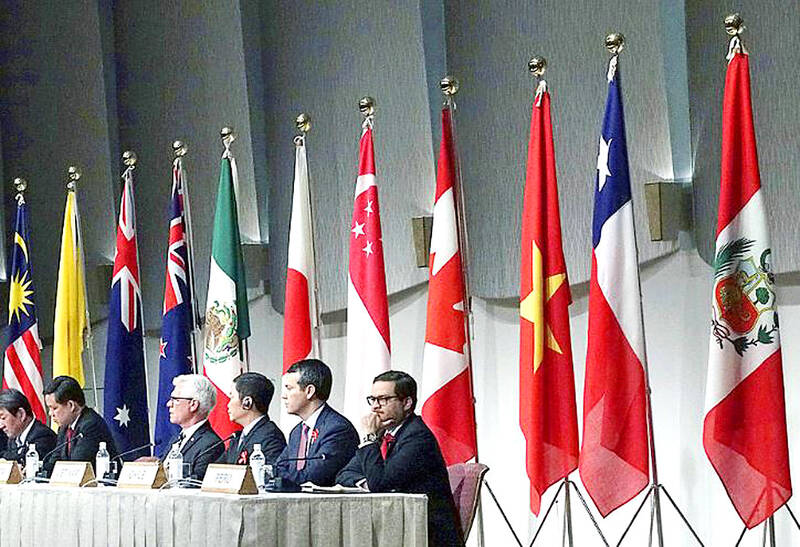Members of a major trans-Pacific trade pact meeting in Auckland today are set to discuss applications by Taiwan and China to join the group, proposals that have deepened the rancor among the neighbors and divided the opinions of member nations.
The Comprehensive and Progressive Agreement for Trans-Pacific Partnership (CPTPP) is also expected to finalize Britain’s membership at the gathering.
China beat Taiwan to apply to join the group by less that a week in 2021, but both applications have been on hold while the British application has been worked through.

Photo: AP
“This is probably the first time there is going to be very serious engagement about what to do about the new applications,” said Charles Finny, a former trade and foreign affairs diplomat for New Zealand who led the country’s negotiations for a trade agreement with Taiwan.
“There is no consensus on that,” he said.
The CPTPP is a landmark trade pact agreed in 2018 between 11 countries — Australia, Brunei, Canada, Chile, Japan, Malaysia, Mexico, New Zealand, Peru, Singapore and Vietnam. Britain is to become the 12th member to join the pact that cuts trade barriers, as it looks to deepen ties in the Pacific.
In support of its application, Britain has said that CPTPP countries would have a combined GDP of £11 trillion (US$14.4 trillion) once Britain joins, or 15 percent of global GDP.
Ministers from the group are expected to discuss a range of topics, including adding new members. It is uncertain that an agreement will be made.
Costa Rica, Uruguay, Ecuador, and most recently Ukraine, have also applied to join the partnership.
China has opposed Taiwan’s application and raised its own bid with the host nation during New Zealand Prime Minister Chris Hipkins’ visit to China last month.
Some member countries support reviewing applications on a first-come-first-served basis, which would put China first, while others want to focus on the best application.
“New Zealand and others were supporting applications being reviewed simultaneously, albeit at potentially different speeds, depending on their ability to meet the high standards, rather than as they came in,” a source close to the matter said.
This would avoid having to pick China or Taiwan or ignore them both.
“The CPTPP is an agreement of very high standards,” Australian Minister for Foreign Affairs Penny Wong (黃英賢) told reporters in Jakarta on Friday.
“All countries who are the original members of the CPTPP would expect those high standards to be able to be met by any country seeking to join,” she said.
For China the hurdle is significant. The CPTPP requires countries to eliminate or reduce tariffs, make solid commitments to opening services and investment markets, and then there are rules around competition, intellectual property rights and protections for foreign companies.
“There are both economic and political complexities,” said Aidan Arasasingham, a research associate at the Center for Strategic and International Studies in Washington.
“There’s a large gap between the high standards and binding commitments that are demanded of CPTPP members, and where China is currently at,” he added.
Revision should be on merit not on dates, said Joanne Ou (歐江安), Taiwan’s de facto ambassador to New Zealand.
“That’s the most transparent and fair way to review them,” she said.
Deputy Minister of Foreign Affairs Roy Lee (李淳) in Taipei last week said that Taiwan “totally” meets the criteria for entry into CPTPP.
However, there are “political issues” that need to be addressed first, he said, without elaborating.

The brilliant blue waters, thick foliage and bucolic atmosphere on this seemingly idyllic archipelago deep in the Pacific Ocean belie the key role it now plays in a titanic geopolitical struggle. Palau is again on the front line as China, and the US and its allies prepare their forces in an intensifying contest for control over the Asia-Pacific region. The democratic nation of just 17,000 people hosts US-controlled airstrips and soon-to-be-completed radar installations that the US military describes as “critical” to monitoring vast swathes of water and airspace. It is also a key piece of the second island chain, a string of

A magnitude 5.9 earthquake that struck about 33km off the coast of Hualien City was the "main shock" in a series of quakes in the area, with aftershocks expected over the next three days, the Central Weather Administration (CWA) said yesterday. Prior to the magnitude 5.9 quake shaking most of Taiwan at 6:53pm yesterday, six other earthquakes stronger than a magnitude of 4, starting with a magnitude 5.5 quake at 6:09pm, occurred in the area. CWA Seismological Center Director Wu Chien-fu (吳健富) confirmed that the quakes were all part of the same series and that the magnitude 5.5 temblor was

Taiwan will now have four additional national holidays after the Legislative Yuan passed an amendment today, which also made Labor Day a national holiday for all sectors. The Chinese Nationalist Party (KMT) and Taiwan People’s Party (TPP) used their majority in the Legislative Yuan to pass the amendment to the Act on Implementing Memorial Days and State Holidays (紀念日及節日實施辦法), which the parties jointly proposed, in its third and final reading today. The legislature passed the bill to amend the act, which is currently enforced administratively, raising it to the legal level. The new legislation recognizes Confucius’ birthday on Sept. 28, the

The Central Weather Administration has issued a heat alert for southeastern Taiwan, warning of temperatures as high as 36°C today, while alerting some coastal areas of strong winds later in the day. Kaohsiung’s Neimen District (內門) and Pingtung County’s Neipu Township (內埔) are under an orange heat alert, which warns of temperatures as high as 36°C for three consecutive days, the CWA said, citing southwest winds. The heat would also extend to Tainan’s Nansi (楠西) and Yujing (玉井) districts, as well as Pingtung’s Gaoshu (高樹), Yanpu (鹽埔) and Majia (瑪家) townships, it said, forecasting highs of up to 36°C in those areas